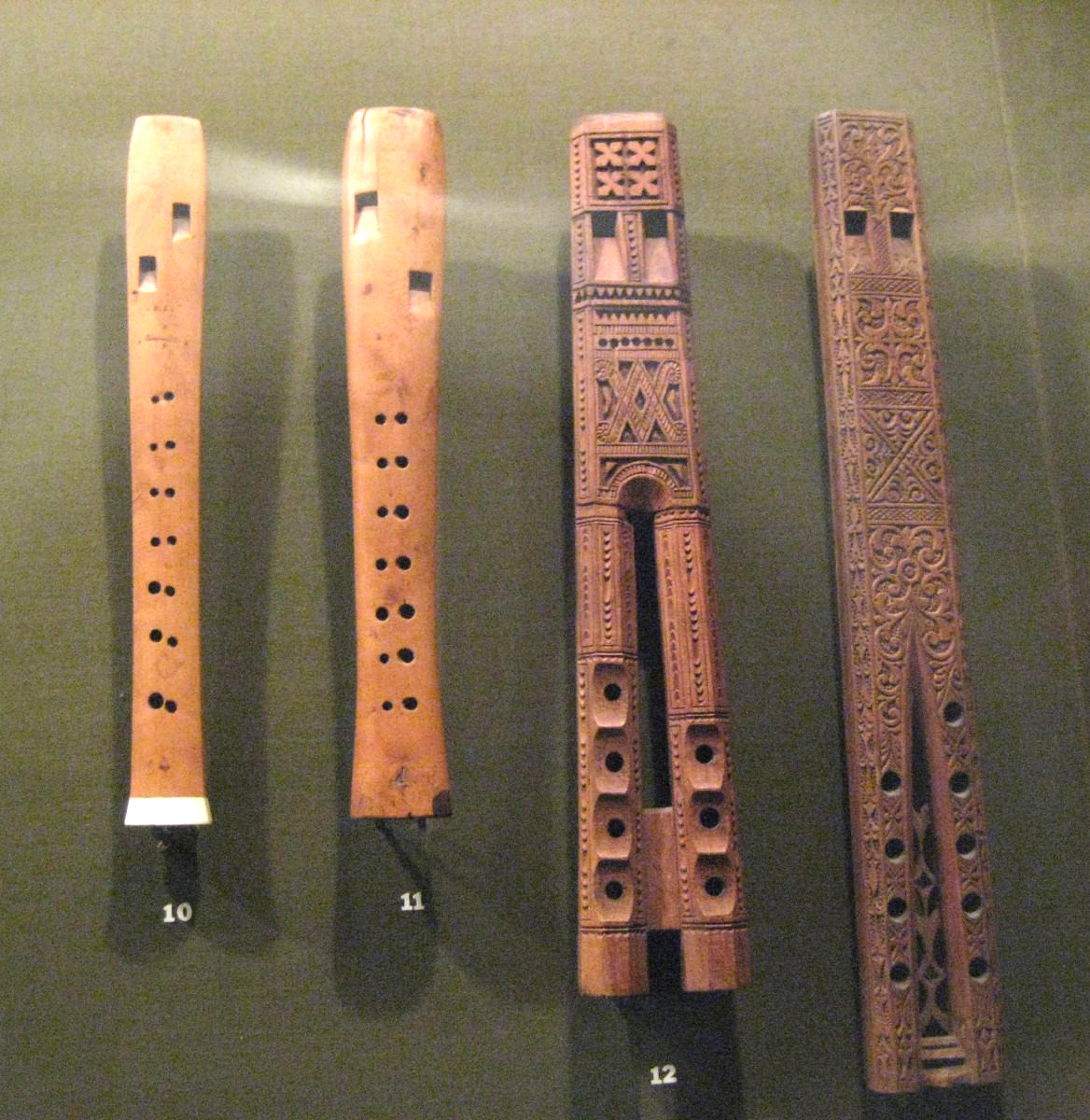double flute on:
[Wikipedia]
[Google]
[Amazon]
 The ''double flute'' is an ancient category of
The ''double flute'' is an ancient category of
File:Aztec double flute.jpg, Aztec double flute uses an air duct to produce sound through the holes in the top of each pipe.
 The ''double flute'' is an ancient category of
The ''double flute'' is an ancient category of wind instrument
A wind instrument is a musical instrument that contains some type of resonator (usually a tube) in which a column of air is set into vibration by the player blowing into (or over) a mouthpiece set at or near the end of the resonator. The pitc ...
, a set of flutes that falls under more than one modern category in the Hornbostel Sachs system of musical instrument classification. The flutes may be double because they have parallel pipes that are connected with a single duct. They may be "double vertical flutes" without a duct. There is also a double-transverse flutes.
Double flutes are not the same as double pipes, which are reed instruments.
Background
Flutes useresonant
Resonance describes the phenomenon of increased amplitude that occurs when the frequency of an applied periodic force (or a Fourier component of it) is equal or close to a natural frequency of the system on which it acts. When an oscillatin ...
pipes to make their sound, whereas pipes use vibrating reeds. The sounding mechanisms for the two types of instrument are different.
Double flutes can be divided into instruments that consist of a melody pipe matched with a drone pipe, and chord flutes in which the instruments can play the same melody at the same time in two different pitches.
Some forms of double flute
The flute is a family of classical music instrument in the woodwind group. Like all woodwinds, flutes are aerophones, meaning they make sound by vibrating a column of air. However, unlike woodwind instruments with reeds, a flute is a reedless ...
include:
* some types of Native American flute
The Native American flute is a flute that is held in front of the player, has open finger holes,
and has two chambers: one for collecting the breath of the player and a second chamber which creates sound.
The player breathes into one end of the ...
s
* the Serbian dvojnice
Diple (pluralia tantum; pronounced , other Croatian names: ''"misnjiče"'', ''"miješnice"'' and ''"mih"'') is a traditional woodwind musical instrument originating in the Croatian Littoral, Adriatic Littoral. It is played in Music of Bosnia and He ...
, can be either a flute or a reed pipe.
* the Bulgarian
Bulgarian may refer to:
* Something of, from, or related to the country of Bulgaria
* Bulgarians, a South Slavic ethnic group
* Bulgarian language, a Slavic language
* Bulgarian alphabet
* A citizen of Bulgaria, see Demographics of Bulgaria
* Bul ...
dvoyanka
*the Indian
Indian or Indians may refer to:
Peoples South Asia
* Indian people, people of Indian nationality, or people who have an Indian ancestor
** Non-resident Indian, a citizen of India who has temporarily emigrated to another country
* South Asia ...
and Pakistani Alghoza
Alghoza is a paired woodwind instrument. It is traditionally used by Baloch, Saraiki, Sindhi, Kutchi, Punjabi and Rajasthani folk musicians. It consists of two joined beak flutes, one for melody, the second for drone. The flutes are either ti ...
*the Iranian
Iranian may refer to:
* Iran, a sovereign state
* Iranian peoples, the speakers of the Iranian languages. The term Iranic peoples is also used for this term to distinguish the pan ethnic term from Iranian, used for the people of Iran
* Iranian lan ...
and Pakistani Donali
Donali (Persian: دونَلی) is an Iranian folk instrument from the Balochistan province in Iran, a pair of fipple flutes that are put in the mouth at the same time to play. The instrument is from the Ney family. The doneli's body is made of re ...
, pair of fipple flute
The term fipple specifies a variety of end-blown flute that includes the flageolet, recorder, and tin whistle. The Hornbostel–Sachs system for classifying musical instruments places this group under the heading "Flutes with duct or duct flute ...
s
* the Russian double svirel
Svirel (russian: свирель) is a folk Russian wind instrument of the end-blown flute type. ''Classification: Aerophone-Whistle Flute-recorder.'' It is a parallel-bore flute. Six-hole versions are similar to the tin whistle; ten-holes are ful ...
, pair of fipple flutes
Some forms that are reed pipes, not double flutes include:
* the ancient Greek
Ancient Greek includes the forms of the Greek language used in ancient Greece and the ancient world from around 1500 BC to 300 BC. It is often roughly divided into the following periods: Mycenaean Greek (), Dark Ages (), the Archaic peri ...
aulos
An ''aulos'' ( grc, αὐλός, plural , ''auloi'') or ''tibia'' (Latin) was an ancient Greek wind instrument, depicted often in art and also attested by archaeology.
Though ''aulos'' is often translated as "flute" or "double flute", it was usu ...
, pair of (double-reed) pipes.
* the Indian
Indian or Indians may refer to:
Peoples South Asia
* Indian people, people of Indian nationality, or people who have an Indian ancestor
** Non-resident Indian, a citizen of India who has temporarily emigrated to another country
* South Asia ...
and Pakistani pungi
The pungi (Hindi: पुंगी, ur, پُنگیپُنگی, Burmese: ပုန်ဂိ), originates from the Indian subcontinent. The instrument consists of a reservoir into which air is blown and then channelled into two reed pipes. It i ...
, reed pipes
* Mijwiz
The ''mijwiz'' ( ar, , DIN: ''miǧwiz'') is a traditional Middle East musical instrument popular in Palestine, Lebanon, Jordan and Syria. Its name in Arabic means "dual," because of its consisting of two, short, bamboo pipes with reed tips p ...
Gallery
References
{{reflist Flutes Hornbostel–Sachs